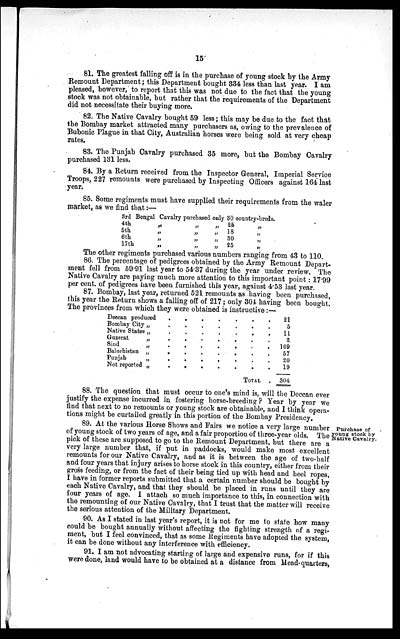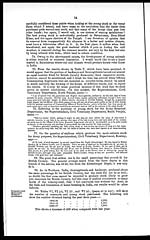Medicine - Veterinary > Civil Veterinary Departments > Annual administration report of the Civil Veterinary Department of India > 1896-1897 > Part I - Imperial report
(33) Page 15
Download files
Individual page:
Thumbnail gallery: Grid view | List view

15
81. The greatest falling off is in the purchase of young stock by the Army
Remount Department; this Department bought 334 less than last year. I am
pleased, however, to report that this was not due to the fact that the young
stock was not obtainable, but rather that the requirements of the Department
did not necessitate their buying more.
82. The Native Cavalry bought 59 less; this may be due to the fact that
the Bombay market attracted many purchasers as, owing to the prevalence of
Bubonic Plague in that City, Australian horses were being sold at very cheap
rates.
83. The Punjab Cavalry purchased 35 more, but the Bombay Cavalry
purchased 131 less.
84. By a Return received from the Inspector General, Imperial Service
Troops, 227 remounts were purchased by Inspecting Officers against 164 last
year.
85. Some regiments must have supplied their requirements from the waler
market, as we find that:—
|
3rd Bengal Cavalry purchased only 30 country-breds. |
|||||
|
4th |
„ |
„ |
„ |
25 |
„ |
|
5th |
„ |
„ |
„ |
18 |
„ |
|
6th |
„ |
„ |
„ |
30 |
„ |
|
17th |
„ |
„ |
„ |
25 |
„ |
The other regiments purchased various numbers ranging from 43 to 110.
86. The percentage of pedigrees obtained by the Army Remount Depart-
ment fell from 59.91 last year to 54.37 during the year under review. The
Native Cavalry are paying much more attention to this important point: 17.99
per cent. of pedigrees have been furnished this year, against 4.53 last year.
87. Bombay, last year, returned 521 remounts as having been purchased,
this year the Return shows a falling off of 217; only 304 having been bought.
The provinces from which they were obtained is instructive:—
|
Decean produced |
. |
. |
. |
. |
. |
. |
. |
21 |
|
Bombay City „ |
. |
. |
. |
. |
. |
. |
. |
5 |
|
Native States „ |
. |
. |
. |
. |
. |
. |
. |
11 |
|
Guzerat „ |
. |
. |
. |
. |
. |
. |
. |
2 |
|
Sind „ |
. |
. |
. |
. |
. |
. |
. |
169 |
|
Baluchistan „ |
. |
. |
. |
. |
. |
. |
. |
57 |
|
Punjab „ |
. |
. |
. |
. |
. |
. |
. |
20 |
|
Not reported „ |
. |
. |
. |
. |
. |
. |
. |
19 |
|
TOTAL |
. |
304 |
||||||
88. The question that must occur to one's mind is, will the Deccan ever
justify the expense incurred in fostering horse-breeding? Year by year we
find that next to no remounts or young stock are obtainable, and I think opera-
tions might be curtailed greatly in this portion of the Bombay Presidency.
Purchase of
young stock by
Native Cavalry.
89. At the various Horse Shows and Fairs we notice a very large number
of young stock of two years of age, and a fair proportion of three-year olds. The
pick of these are supposed to go to the Remount Department, but there are a
very large number that, if put in paddocks, would make most excellent
remounts for our Native Cavalry, and as it is between the age of two-half
and four years that injury arises to horse stock in this country, either from their
gross feeding, or from the fact of their being tied up with head and heel ropes,
I have in former reports submitted that a certain number should be bought by
each Native Cavalry, and that they should be placed in runs until they are
four years of age. I attach so much importance to this, in connection with
the remounting of our Native Cavalry, that I trust that the matter will receive
the serious attention of the Military Department.
90. As I stated in last year's report, it is not for me to state how many
could be bought annually without affecting the fighting strength of a regi-
ment, but I feel convinced, that as some Regiments have adopted the system,
it can be done without any interference with efficiency.
91. I am not advocating starting of large and expensive runs, for if this
were done, land would have to be obtained at a distance from Head quarters,
Set display mode to: Large image | Zoom image | Transcription
Images and transcriptions on this page, including medium image downloads, may be used under the Creative Commons Attribution 4.0 International Licence unless otherwise stated. ![]()
| India Papers > Medicine - Veterinary > Civil Veterinary Departments > Annual administration report of the Civil Veterinary Department of India > 1896-1897 > Imperial report > (33) Page 15 |
|---|
| Permanent URL | https://digital.nls.uk/75503599 |
|---|




